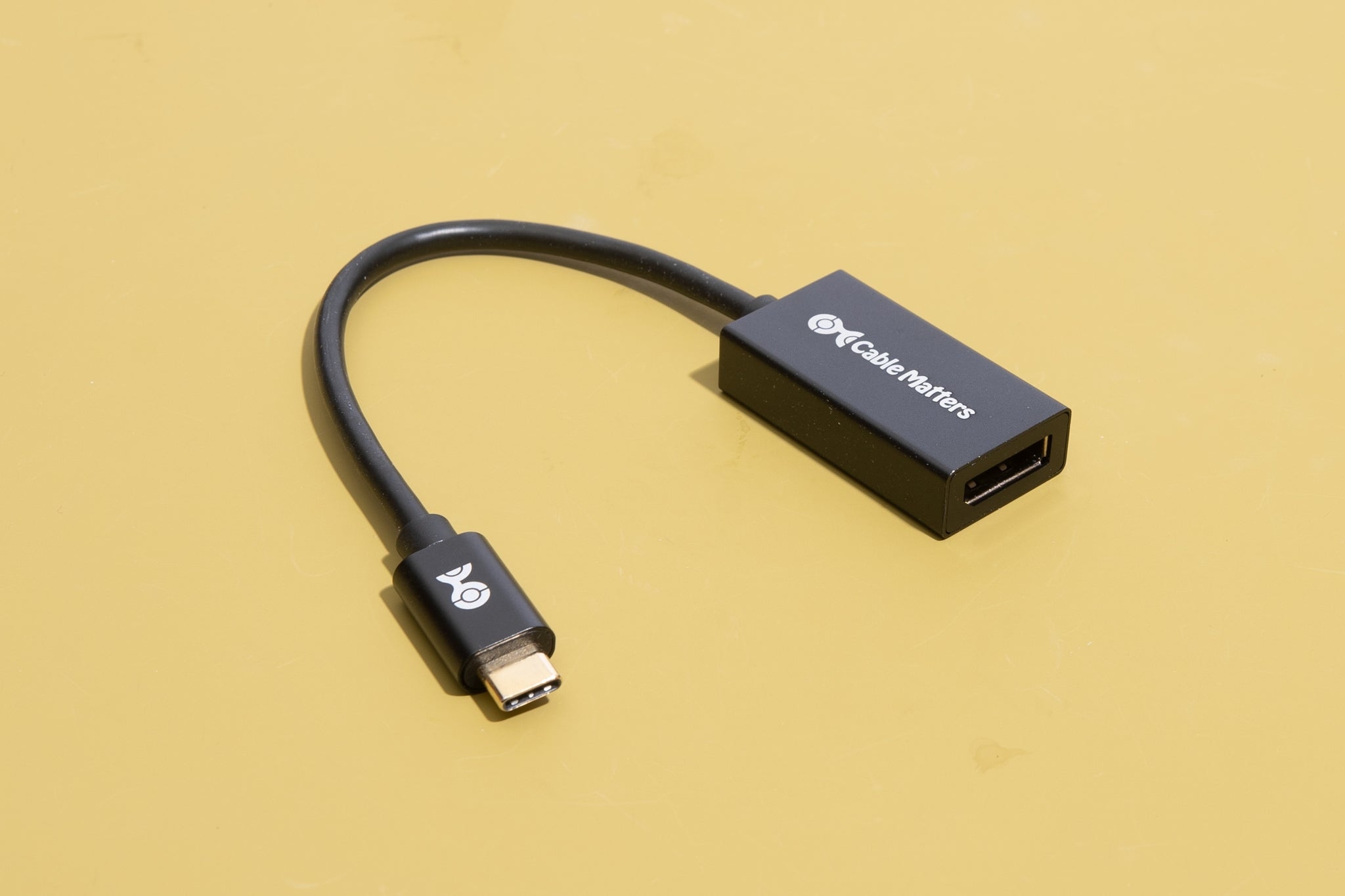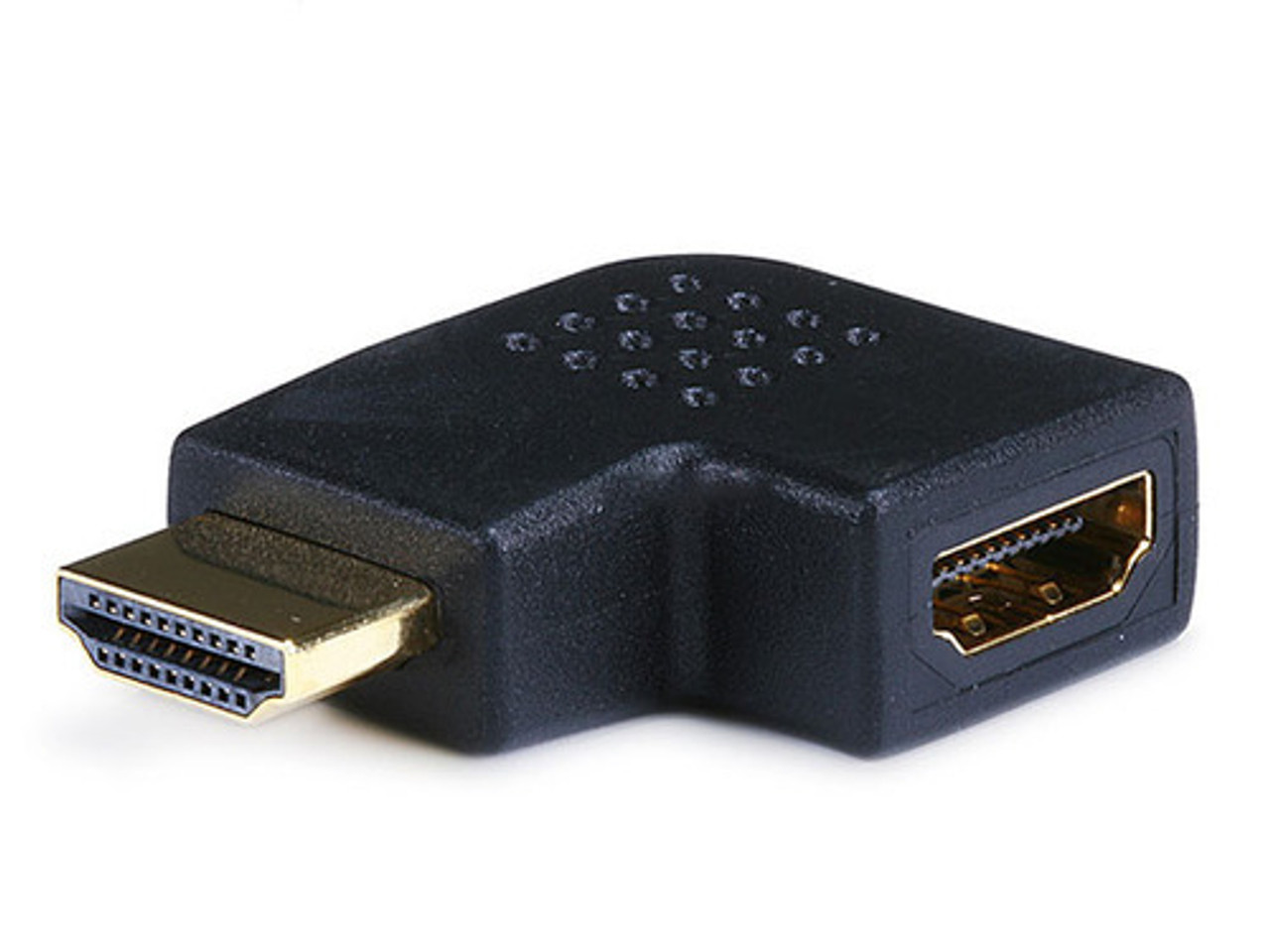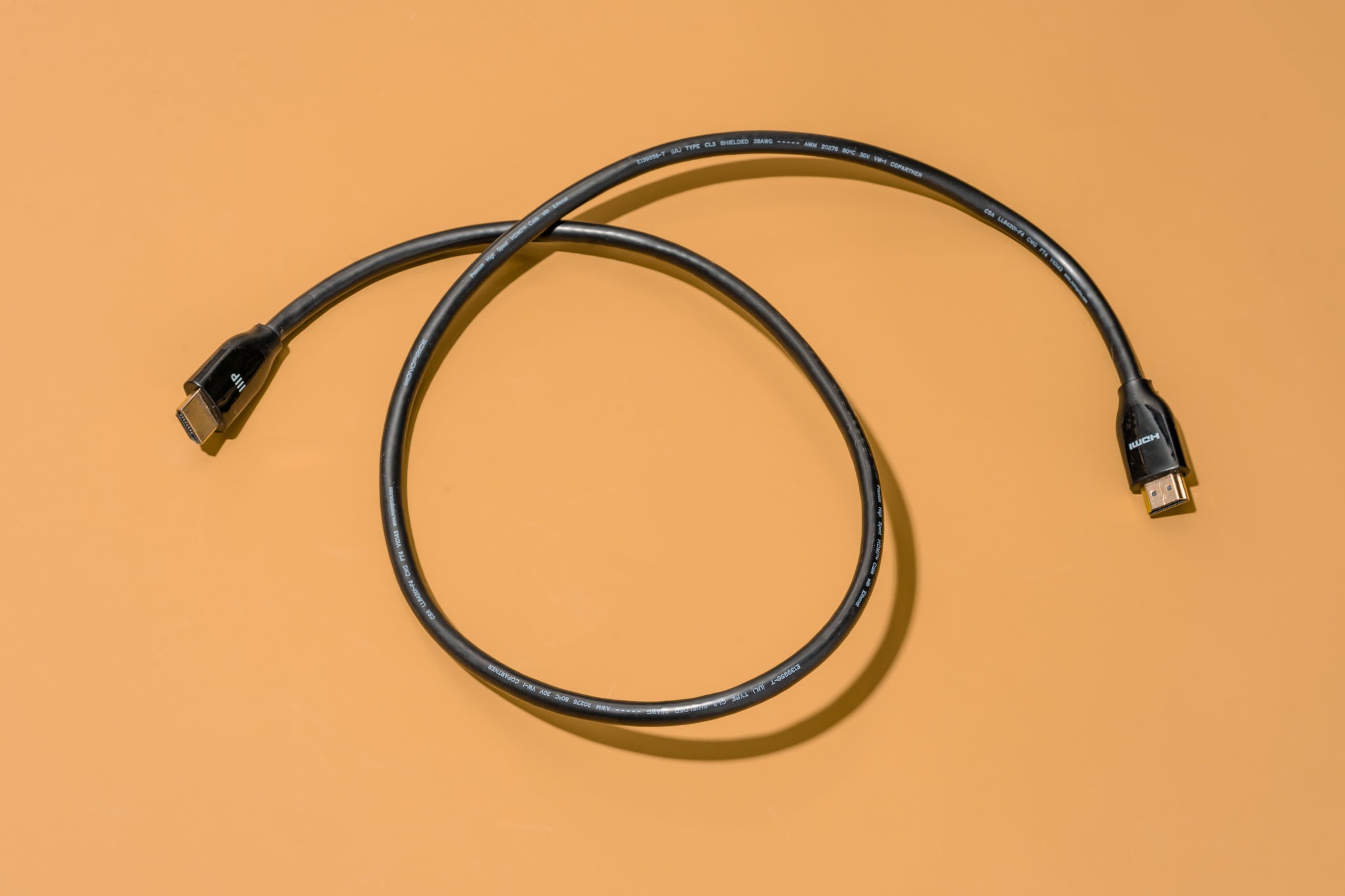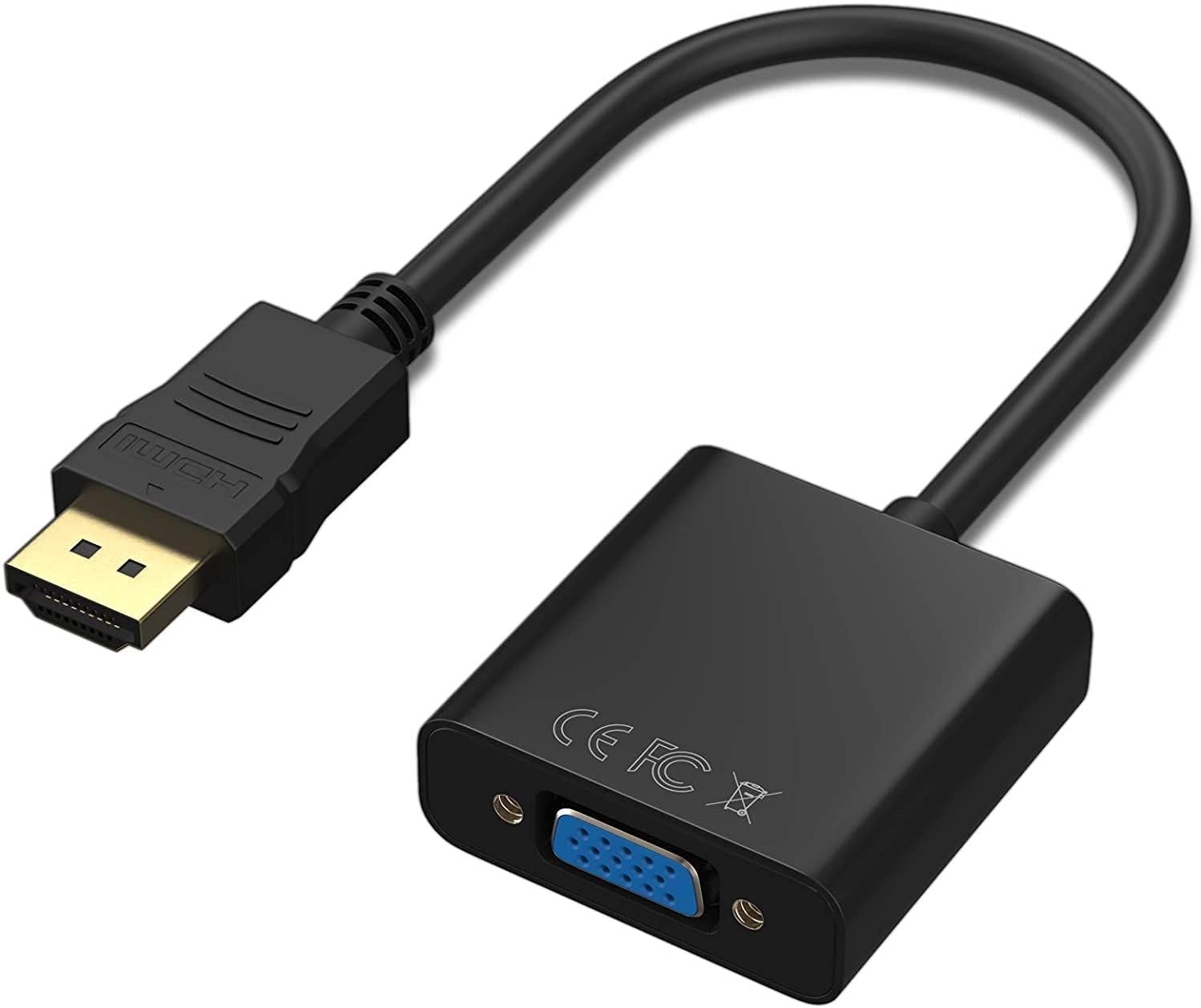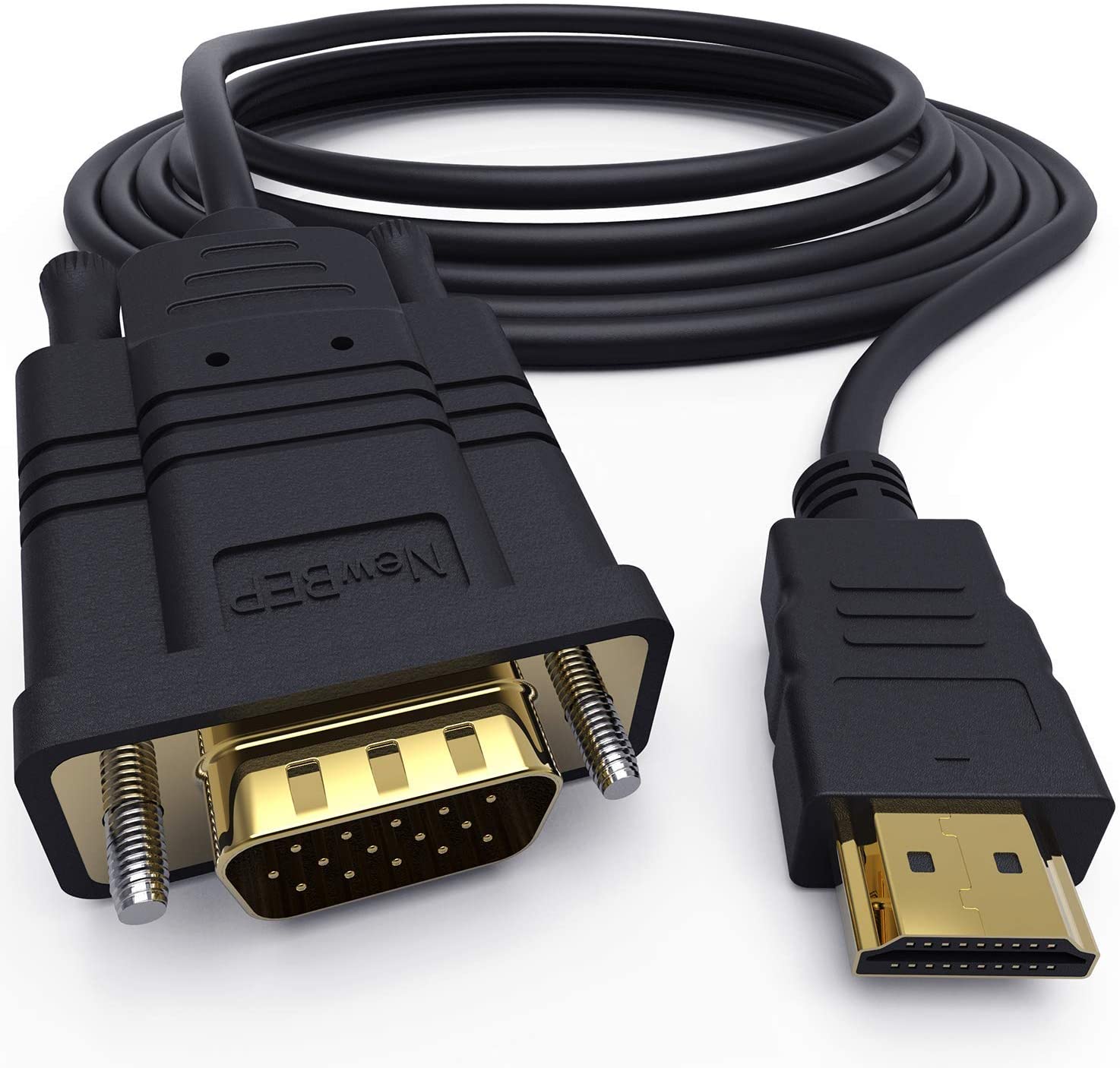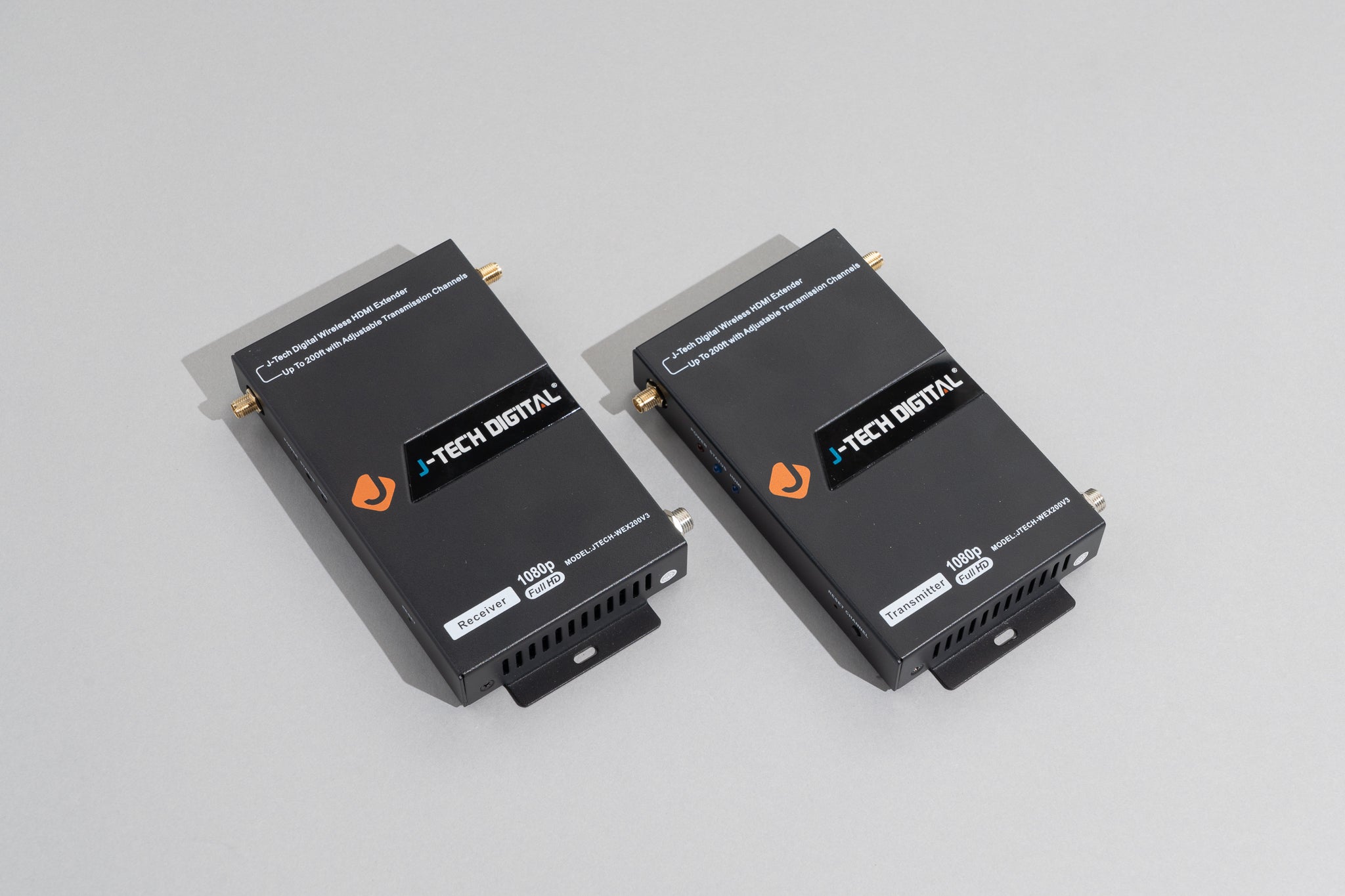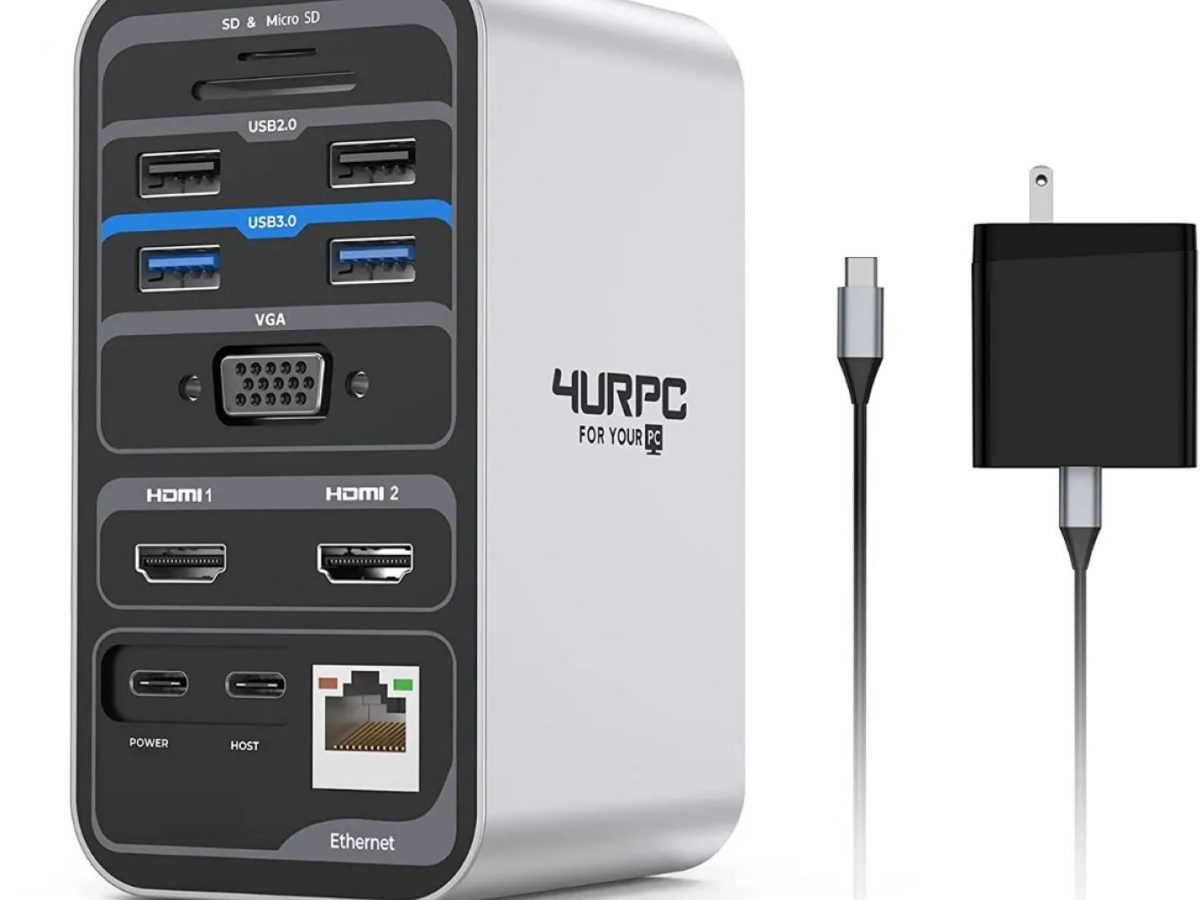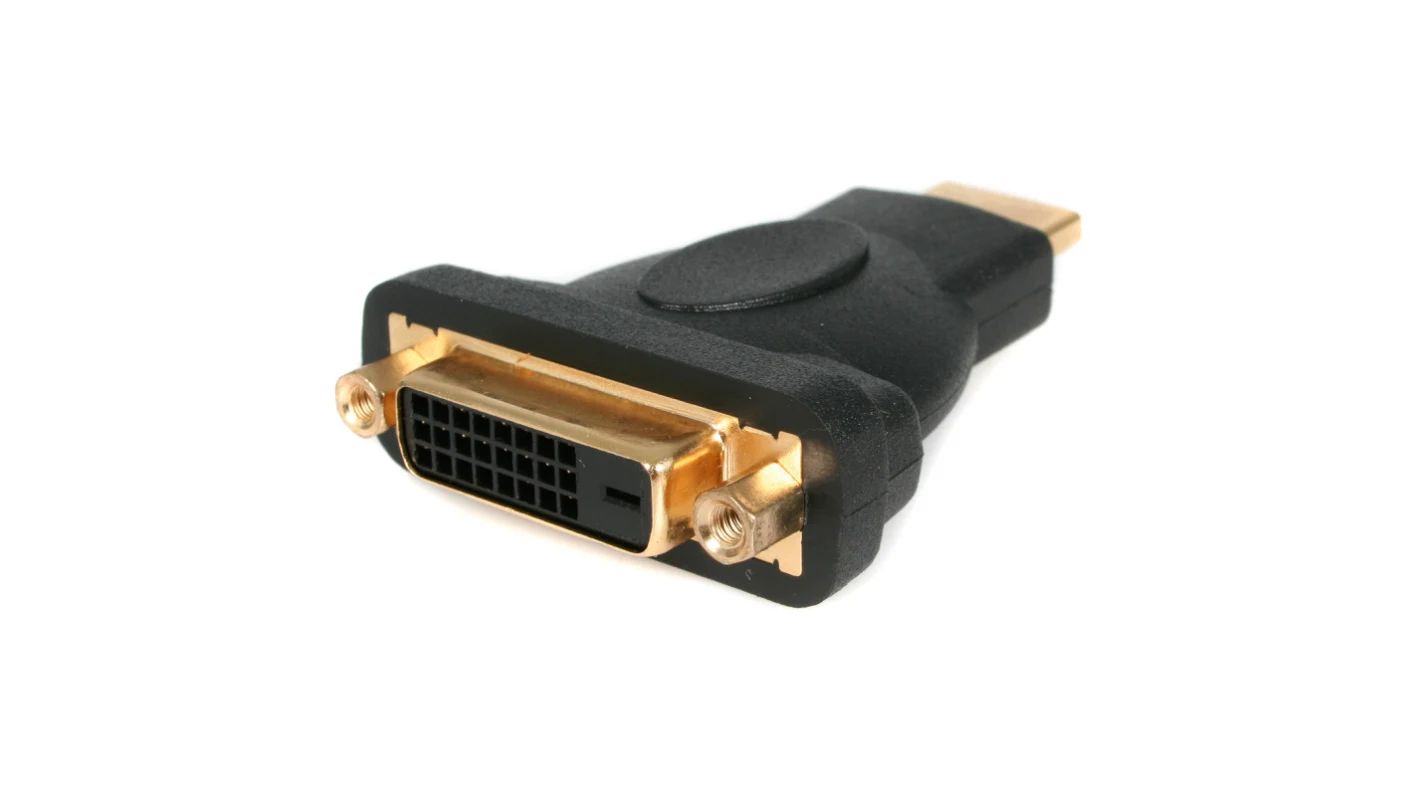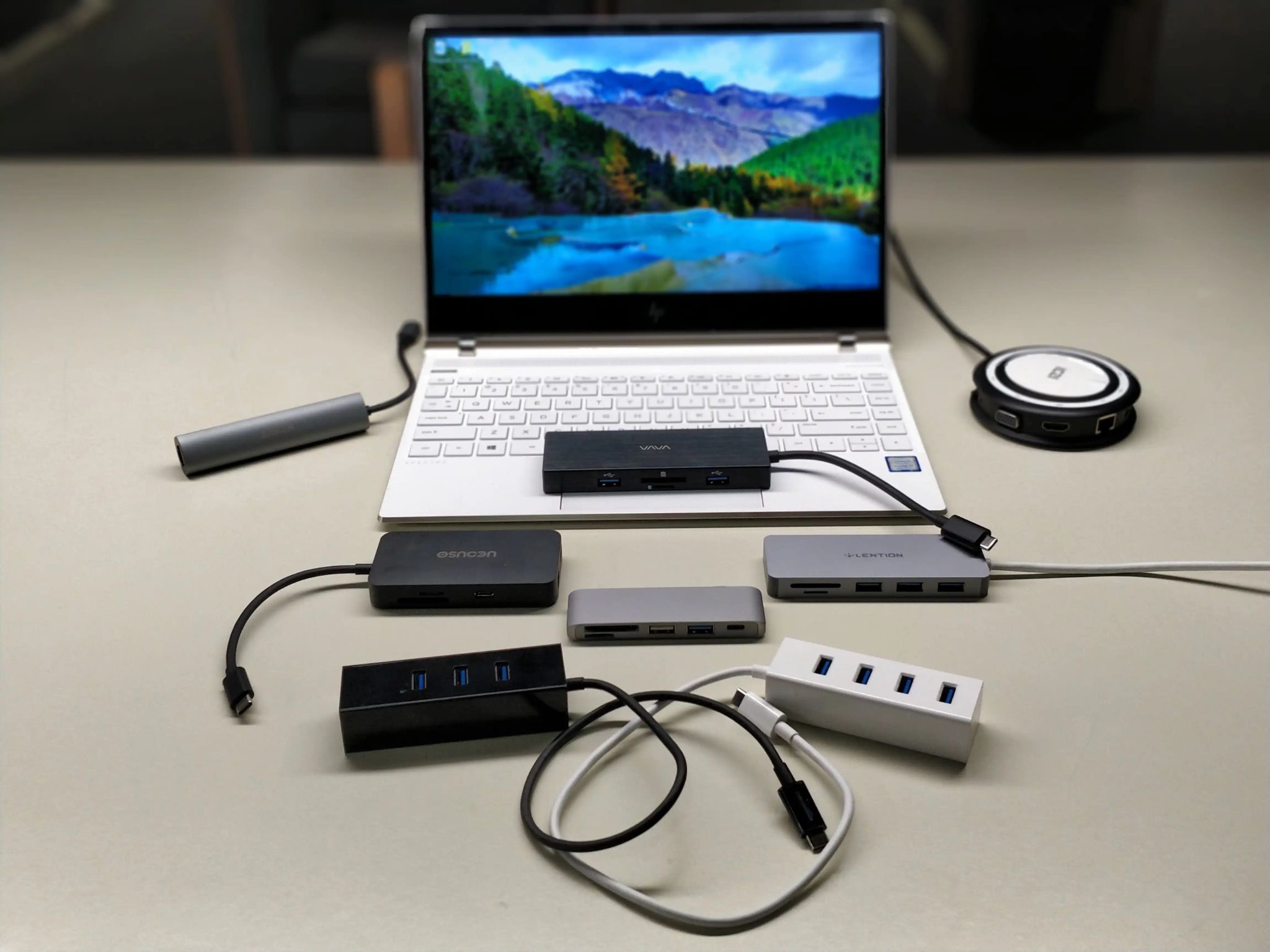What Is an HDMI Adapter?
An HDMI adapter is a device that allows you to connect different types of devices with HDMI ports to those with other types of ports, enabling seamless audio and video transmission. HDMI stands for High Definition Multimedia Interface, and it has become the standard for transmitting high-quality digital audio and video signals between devices.
HDMI adapters come in various types, each designed to convert the HDMI signal to a different type of connection. These adapters are commonly used to connect devices like laptops, desktop computers, gaming consoles, and DVD players to external displays such as monitors, projectors, and televisions.
One of the most popular types of HDMI adapters is the HDMI to VGA adapter. This adapter is used to connect HDMI devices to displays that only have a VGA input. It converts the digital HDMI signal to an analog VGA signal, allowing you to connect devices like laptops to older VGA monitors.
Another common type is the HDMI to DVI adapter, which is used to connect HDMI devices to displays with a DVI input. This adapter is commonly used to connect computers to DVI monitors or projectors.
If you have a device with a DisplayPort, there are HDMI to DisplayPort adapters available as well. These adapters enable you to connect HDMI devices to displays with a DisplayPort input, such as high-resolution monitors.
HDMI to USB adapters are useful when you want to connect HDMI devices to computers or laptops that have USB ports but no HDMI ports. These adapters convert the HDMI signal to a USB signal, allowing you to display the content on your computer screen.
In situations where you need to extend your HDMI connection over long distances, HDMI to Ethernet adapters come in handy. They utilize Ethernet cables to transmit the audio and video signals, enabling longer cable runs without signal loss.
For connecting HDMI devices to older televisions or projectors with RCA inputs, HDMI to RCA adapters can be used. These adapters convert the HDMI signal to an analog RCA signal, ensuring compatibility with older audio and video components.
If you have devices with mini HDMI or micro HDMI ports, there are specific adapters available for those as well. HDMI to Mini HDMI and HDMI to Micro HDMI adapters allow you to connect these devices to regular HDMI cables for easy connectivity.
Lastly, there are HDMI to 3.5mm audio adapters available. These adapters separate the audio and video signals from the HDMI cable, allowing you to connect external speakers or headphones with a 3.5mm audio jack.
Overall, HDMI adapters provide versatile solutions for connecting various devices, ensuring compatibility and seamless transmission of audio and video signals between different ports.
Different Types of HDMI Adapters
HDMI adapters come in various types, each designed to meet specific connectivity needs and bridge the gap between different types of ports. Understanding the different types of HDMI adapters available can help you choose the right one for your specific device and display requirements. Let’s take a closer look at some of the most commonly used HDMI adapters:
- HDMI to VGA Adapter: This type of adapter allows you to connect HDMI devices, such as laptops or gaming consoles, to VGA displays, which are commonly found in older monitors or projectors. It converts the digital HDMI signal to an analog VGA signal, providing compatibility between the two port types.
- HDMI to DVI Adapter: This adapter is used to connect HDMI devices to displays that only have a DVI input. It is commonly used for connecting computers or set-top boxes to DVI monitors or projectors.
- HDMI to DisplayPort Adapter: If you have a display with a DisplayPort input and want to connect an HDMI device, this adapter will come in handy. It allows you to convert the HDMI signal to a DisplayPort signal, ensuring seamless compatibility between the devices.
- HDMI to USB Adapter: This type of adapter enables you to connect HDMI devices, such as laptops or cameras, to computers or laptops that have USB ports but no HDMI ports. It converts the HDMI signal to a USB signal, allowing you to share the content on your computer screen.
- HDMI to Ethernet Adapter: If you need to extend your HDMI connection over long distances, HDMI to Ethernet adapters can be used. They utilize Ethernet cables to transmit the audio and video signals, allowing for longer cable runs without signal degradation.
- HDMI to RCA Adapter: This adapter is useful when you want to connect HDMI devices to older televisions or projectors that only have RCA inputs. It converts the digital HDMI signal to an analog RCA signal, ensuring compatibility with older audio and video components.
- HDMI to Mini HDMI/Micro HDMI Adapter: These adapters are designed for devices with mini HDMI or micro HDMI ports. They allow you to connect these devices to regular HDMI cables, ensuring seamless connectivity with a wider range of devices.
- HDMI to 3.5mm Audio Adapter: If you want to connect external speakers or headphones with a 3.5mm audio jack to your HDMI device, this adapter is essential. It separates the audio and video signals from the HDMI cable, enabling you to enjoy audio output through compatible external devices.
With a wide range of HDMI adapters available, you can easily find a solution that suits your specific connectivity requirements. Whether you need to connect to older displays, different port types, or extend your HDMI connection, there is an adapter designed to meet your needs.
HDMI to VGA Adapter
The HDMI to VGA adapter is a commonly used adapter that allows you to connect devices with HDMI ports to displays that only have a VGA input. This adapter is particularly useful when you want to connect HDMI devices, such as laptops, gaming consoles, or streaming devices, to older monitors or projectors that only support VGA. Let’s take a closer look at how the HDMI to VGA adapter works and its key features:
Functionality: The HDMI to VGA adapter converts the digital HDMI signal to an analog VGA signal. This conversion is necessary because HDMI uses a digital signal, while VGA uses an analog signal. The adapter acts as a bridge between the two port types, allowing seamless compatibility and transmission of audio and video signals.
Video Resolution: The HDMI to VGA adapter supports various video resolutions, including common resolutions like 1080p and 720p. However, it’s important to note that the adapter’s output resolution will depend on the capabilities of your VGA display. It may not support higher resolutions, so it’s recommended to check the specifications of your display before connecting the devices.
Audio Support: It’s important to note that the HDMI to VGA adapter only supports video signal transmission. It does not convert or transmit audio signals. This means that if you’re using the adapter to connect your laptop or gaming console to a VGA display, you will need a separate audio connection. You can use the headphone jack or an audio cable to connect the audio output of your device to external speakers or headphones for audio output.
Plug-and-Play: Most HDMI to VGA adapters are plug-and-play, which means they do not require additional drivers or software to function. Simply connect the HDMI end of the adapter to your device and the VGA end to your display, and the adapter will start converting and transmitting the signal. However, it’s important to ensure that both the HDMI and VGA ports are compatible with the corresponding adapter ends.
Compact and Portable: HDMI to VGA adapters are generally compact and portable, making them easy to carry around and use in different environments. Whether you’re in a classroom, office, or a conference room, the adapter can be easily connected to your HDMI device and VGA display, allowing you to share your screen effortlessly.
The HDMI to VGA adapter is a versatile tool that allows you to connect modern devices with HDMI ports to older displays with VGA inputs. Whether you need to connect your laptop for a presentation or play games on an older projector, this adapter provides a convenient solution for ensuring compatibility and seamless audio and video transmission.
HDMI to DVI Adapter
The HDMI to DVI adapter is a widely used adapter that enables the connection between devices with HDMI ports and displays with DVI inputs. This adapter is particularly useful when you want to connect HDMI devices, such as computers, gaming consoles, or set-top boxes, to DVI monitors, projectors, or televisions. Let’s explore the functionality and key features of the HDMI to DVI adapter:
Signal Conversion: The HDMI to DVI adapter functions by converting the digital HDMI signal to a digital DVI signal. Unlike the HDMI interface, which carries both audio and video signals, DVI supports video signals only. This adapter enables you to bridge the gap between HDMI and DVI ports, allowing seamless compatibility between devices.
Video Resolution: The HDMI to DVI adapter supports various video resolutions, including common resolutions like 1080p and 720p. The output resolution will depend on the limits of your connected DVI display. It’s recommended to verify the specifications of your display to ensure proper compatibility and optimal video quality.
Audio Support: It’s important to note that the HDMI to DVI adapter does not transmit audio signals. DVI connections do not carry audio, so if you’re using this adapter to connect a device with an HDMI port to a DVI display, you will need an alternative audio connection. You can use the headphone jack or a separate audio cable to connect the audio output of your HDMI device to external speakers or headphones.
Plug-and-Play: Most HDMI to DVI adapters are plug-and-play, meaning they don’t require any additional software or drivers to function. Simply connect the HDMI end of the adapter to your device and the DVI end to your display. The adapter will then convert and transmit the signal without any manual configuration. Note that both the HDMI and DVI ports need to be compatible with the respective ends of the adapter.
Dual-Link and Single-Link: HDMI to DVI adapters are available in both dual-link and single-link versions. Dual-link adapters are capable of supporting higher resolutions, such as 2560×1600, while single-link adapters are limited to resolutions up to 1920×1200. Be sure to choose the appropriate adapter that aligns with your display’s maximum resolution for optimal performance.
Compatibility: The HDMI to DVI adapter allows for backward compatibility, meaning that it can connect devices with HDMI 2.0, HDMI 1.4, HDMI 1.3, or earlier versions to DVI displays. However, if you’re connecting a DVI device to an HDMI display, a separate DVI to HDMI adapter or cable will be required.
The HDMI to DVI adapter offers a convenient solution for connecting HDMI devices to DVI displays, allowing for seamless video transmission and compatibility. Whether you’re working on a dual-monitor setup, gaming on a DVI monitor, or delivering presentations, this adapter ensures that your HDMI devices can be easily connected to DVI displays without hassle.
HDMI to DisplayPort Adapter
The HDMI to DisplayPort adapter is a versatile adapter that enables the connection between devices with HDMI ports and displays with DisplayPort inputs. This adapter is particularly useful when you want to connect HDMI devices, such as laptops, gaming consoles, or media players, to high-resolution monitors or projectors equipped with DisplayPort. Let’s delve into the functionality and key features of the HDMI to DisplayPort adapter:
Signal Conversion: The HDMI to DisplayPort adapter performs the vital function of converting the digital HDMI signal to a digital DisplayPort signal. By facilitating the transformation between the two port types, seamless compatibility and transmission of audio and video signals are achieved.
Video Resolution: The HDMI to DisplayPort adapter supports multiple video resolutions, including standard resolutions like 1080p and 720p, as well as higher resolutions like 4K or even 8K for newer models. It’s important to note that the adapter’s capabilities may vary depending on the specific model and the supported resolutions of your DisplayPort display.
Audio Support: Similar to other HDMI adapters, the HDMI to DisplayPort adapter does not transmit audio signals. DisplayPort connections can carry audio, but HDMI connections incorporate both video and audio signals. Therefore, if you use the adapter to connect an HDMI device to a DisplayPort display, you will need an alternate audio connection. This can be achieved through the device’s headphone jack or by using a separate audio cable.
Plug-and-Play: Most HDMI to DisplayPort adapters are plug-and-play, meaning they do not require additional drivers or software installation. Simply connect the HDMI end of the adapter to your device and the DisplayPort end to your display. The adapter will automatically detect and convert the signal, ensuring hassle-free setup and usage.
Compatibility: HDMI to DisplayPort adapters are designed to work in both directions, allowing HDMI devices to connect to DisplayPort displays, as well as DisplayPort devices to connect to HDMI displays. This enables greater flexibility when it comes to compatibility and connectivity options.
Extended Desktop and Mirrored Display: With an HDMI to DisplayPort adapter, you can extend your desktop across multiple displays or mirror your screen on a DisplayPort monitor. This can be highly beneficial for tasks that require a larger workspace, such as graphics design, video editing, or gaming.
Resolution and Refresh Rate: When selecting an HDMI to DisplayPort adapter, ensure that it supports the maximum resolution and refresh rate of your HDMI device and DisplayPort display. Different models may have varying capabilities, so it’s important to choose one that aligns with your specific requirements.
The HDMI to DisplayPort adapter offers a convenient solution for connecting HDMI devices to displays equipped with DisplayPort inputs. Be it for work, gaming, or multimedia purposes, this adapter enhances compatibility and allows for seamless transmission of audio and video signals between HDMI devices and DisplayPort displays.
HDMI to USB Adapter
The HDMI to USB adapter is a useful accessory that enables the connection between devices with HDMI ports and computers or laptops with USB ports. This adapter is particularly beneficial when you want to display the content from HDMI devices, such as laptops, gaming consoles, or cameras, on your computer screen. Let’s explore the functionality and key features of the HDMI to USB adapter:
Signal Conversion: The HDMI to USB adapter converts the digital HDMI signal to a USB signal, allowing the content from HDMI devices to be transmitted and displayed on a computer or laptop screen. This conversion is necessary because HDMI and USB use different signal formats and protocols.
Display Mirroring: The adapter allows for display mirroring, meaning that the content from the HDMI device is mirrored on the computer screen. This can be useful for various applications, such as presenting slideshows, sharing videos, or conducting online meetings using your HDMI device as a source.
Video Resolution: The HDMI to USB adapter supports various video resolutions, including common resolutions like 1080p and 720p. However, the actual output resolution will depend on the capabilities of your computer or laptop’s USB port and graphics card. It’s recommended to check the specifications of your device to ensure optimal video quality.
Plug-and-Play: Most HDMI to USB adapters are plug-and-play devices, meaning they do not require additional software or drivers to function. Simply connect the HDMI end of the adapter to your device and the USB end to the computer or laptop’s USB port. The adapter will then start converting and transmitting the signal, allowing you to see the content on your computer screen.
Audio Support: It’s important to note that not all HDMI to USB adapters support audio transmission. Some adapters focus solely on video display, while others include audio transmission capabilities. If audio is important for your application, be sure to select an adapter that specifically mentions audio support.
Compatibility: HDMI to USB adapters are generally compatible with various operating systems, including Windows, macOS, and Linux. However, it’s still advisable to check the compatibility specifications of the adapter and ensure that it works seamlessly with your device’s operating system.
Compact and Portable: HDMI to USB adapters are usually compact and portable, making them easy to carry and use in different environments. Whether you’re at home, in the office, or on the go, the adapter can be easily connected to your HDMI device and USB port, allowing you to share and display content conveniently.
The HDMI to USB adapter provides a simple and effective solution for connecting HDMI devices to computers or laptops that lack HDMI ports. Whether you need to present, collaborate, or share content, this adapter allows you to leverage the computing power of your device, making it a versatile tool for various applications.
HDMI to Ethernet Adapter
The HDMI to Ethernet adapter is a unique accessory that enables the extension of HDMI connections over long distances using Ethernet cables. This adapter is particularly useful when you need to transmit audio and video signals from HDMI devices to a display that is far away, ensuring reliable and high-quality transmission. Let’s explore the functionality and key features of the HDMI to Ethernet adapter:
HDMI Extension: The HDMI to Ethernet adapter works by utilizing Ethernet cables for extending HDMI connections. It converts the HDMI signal into an Ethernet signal and then converts it back to HDMI at the other end, allowing for seamless transmission between the HDMI device and the display.
Long-Distance Transmission: The HDMI to Ethernet adapter enables HDMI signals to be transmitted over long distances. Ethernet cables have the advantage of being able to achieve extended cable runs without signal degradation. This makes the adapter suitable for applications where the HDMI device and the display are located far apart, such as in large conference rooms, classrooms, or home theater setups.
Video Resolution: The adapter supports various video resolutions, including common resolutions like 1080p and 720p, ensuring that the transmitted video is of high quality. However, it’s essential to note that the ultimate video resolution will depend on the capabilities of the HDMI device and the display being used.
Plug-and-Play: Most HDMI to Ethernet adapters are plug-and-play devices, meaning they can be connected without the need for additional drivers or software installations. Simply connect the HDMI end of the adapter to the HDMI source device and the other end to the display using an Ethernet cable. The adapter will begin converting and transmitting the signal automatically.
Audio Support: Like other HDMI adapters, the HDMI to Ethernet adapter can transmit audio signals along with the video signal, ensuring a complete and immersive audio-visual experience. The audio capabilities will depend on the audio support of the HDMI device and the display being used.
Compatibility: The HDMI to Ethernet adapter is generally compatible with various HDMI devices, including computers, gaming consoles, Blu-ray players, and more. It’s also compatible with displays that have HDMI inputs. Ensure that the adapter you choose is compatible with the specific devices you want to connect.
Cost and Convenience: The HDMI to Ethernet adapter provides a cost-effective solution for extending HDMI connections compared to using long HDMI cables. Ethernet cables are often more affordable, readily available, and easier to manage in terms of installation and cable management.
The HDMI to Ethernet adapter offers a practical and efficient solution for extending HDMI connections over long distances. Whether you need to transmit audio and video signals between rooms or from one end of a large space to another, this adapter ensures reliable and high-quality transmission while maintaining compatibility with HDMI devices and displays.
HDMI to RCA Adapter
The HDMI to RCA adapter is a valuable accessory that allows you to connect HDMI devices to older televisions or projectors that only have RCA inputs. This adapter is particularly useful when you want to enjoy the content from HDMI devices, such as gaming consoles, Blu-ray players, or streaming devices, on older audio and video components. Let’s delve into the functionality and key features of the HDMI to RCA adapter:
Signal Conversion: The HDMI to RCA adapter performs the essential task of converting the digital HDMI signal to an analog RCA signal. HDMI transmits digital signals, while RCA uses analog signals. The adapter acts as an interface between the two, allowing seamless compatibility and transmission of audio and video signals.
Video and Audio Support: The adapter converts both the video and audio signals, ensuring that both components of the HDMI signal are properly transmitted to the RCA input. This allows you to enjoy both the visual and audio aspects of your HDMI devices on older TVs or projectors that lack HDMI inputs.
Video Resolution: The HDMI to RCA adapter supports various video resolutions, including common resolutions like 1080p and 720p. However, it’s important to note that the output resolution will depend on the capabilities of the RCA display. Older displays may have lower maximum resolutions, so the actual output resolution may be lower than the native HDMI resolution.
Audio Conversion: The adapter converts the digital audio signal from HDMI to an analog audio signal that can be transmitted through the RCA cables. This allows you to connect the audio output of your HDMI device to external speakers or amplifiers that only have RCA inputs, enabling you to enjoy the audio component of your content as well.
Plug-and-Play: Most HDMI to RCA adapters are plug-and-play devices. There is no need for additional drivers or software installations. Simply connect the HDMI end of the adapter to your device and the RCA end to the RCA input on your TV or projector. The adapter will begin converting and transmitting the signal automatically.
Compatibility: HDMI to RCA adapters are designed for compatibility with various HDMI devices, including gaming consoles, Blu-ray players, and more. They are also compatible with older televisions or projectors that have RCA inputs but lack HDMI inputs. Be sure to choose an adapter that is compatible with the specific devices you want to connect.
Convenience: The HDMI to RCA adapter offers a convenient solution for connecting HDMI devices to older audio and video components. It eliminates the need for replacing or upgrading your existing equipment and allows you to continue using your RCA-equipped devices to enjoy the content from HDMI sources.
The HDMI to RCA adapter serves as a valuable bridge between HDMI devices and older RCA displays. By converting the digital HDMI signal to analog RCA, it enables seamless connectivity and transmission of audio and video signals, allowing you to enjoy your HDMI content on older televisions or projectors without any hassle.
HDMI to Mini HDMI Adapter
The HDMI to Mini HDMI adapter is a versatile accessory that allows you to connect devices with a regular HDMI port to devices with a mini HDMI port. This adapter is particularly useful when you want to connect devices like cameras, tablets, or certain laptops to displays or TVs that have a standard HDMI input. Let’s explore the functionality and key features of the HDMI to Mini HDMI adapter:
Connection Compatibility: The adapter is designed to bridge the gap between the standard HDMI (Type A) and mini HDMI (Type C) ports. It allows you to connect HDMI devices, such as cameras or tablets, to displays or TVs equipped with a regular HDMI input. This provides seamless compatibility and enables audio and video transmission between the connected devices.
Signal Conversion: The HDMI to Mini HDMI adapter converts the digital HDMI signal to a mini HDMI format. It ensures that the video and audio signals from the HDMI device are properly transmitted to the mini HDMI input, without any loss or degradation in quality.
Video Resolution: The adapter supports various video resolutions, including standard resolutions like 1080p and 720p. However, it’s important to note that the actual output resolution will depend on the capabilities of your device’s mini HDMI port and the connected display. It’s recommended to check the specifications of both devices to ensure optimal video quality.
Audio Support: The HDMI to Mini HDMI adapter allows for the transmission of audio signals along with the video signal. It ensures that the audio component of your content is properly transmitted from the HDMI device to the mini HDMI input, enabling you to enjoy a complete audio-visual experience on the connected display or TV.
Plug-and-Play: Most HDMI to Mini HDMI adapters are plug-and-play devices. They do not require any additional drivers or software installations. Simply connect the HDMI end of the adapter to your device and the mini HDMI end to the mini HDMI input on the display or TV. The adapter will automatically start converting and transmitting the signal.
Compact and Portable: HDMI to Mini HDMI adapters are typically compact and portable, making them convenient to carry and use in different environments. Whether you’re traveling, giving presentations, or simply connecting your devices at home, the adapter can easily be connected to provide seamless compatibility and reliable signal transmission.
Compatibility: The HDMI to Mini HDMI adapter works with various HDMI devices that have a standard HDMI port. This includes laptops, cameras, tablets, and more. The adapter allows these devices to connect to displays or TVs that have a mini HDMI input, ensuring compatibility and flexibility in device connectivity.
The HDMI to Mini HDMI adapter provides a simple and effective solution for connecting devices with a regular HDMI port to devices with a mini HDMI port. Whether you’re sharing media, conducting presentations, or displaying content from your devices, this adapter ensures seamless compatibility and reliable audio and video transmission between connected devices.
HDMI to Micro HDMI Adapter
The HDMI to Micro HDMI adapter is a versatile accessory that allows you to connect devices with a standard HDMI port to devices with a micro HDMI port. This adapter is particularly useful when you want to connect devices like smartphones, tablets, or certain cameras to displays or TVs that have a regular HDMI input. Let’s explore the functionality and key features of the HDMI to Micro HDMI adapter:
Connection Compatibility: The adapter serves as a bridge between devices with a regular HDMI (Type A) port and devices with a micro HDMI (Type D) port. It enables you to connect HDMI devices, such as smartphones or tablets, to displays or TVs equipped with a standard HDMI input. This ensures seamless compatibility and allows for audio and video transmission between the connected devices.
Signal Conversion: The HDMI to Micro HDMI adapter converts the digital HDMI signal to a micro HDMI format. It ensures that the video and audio signals from the HDMI device are properly transmitted to the micro HDMI input, without any loss or degradation in quality.
Video Resolution: The adapter supports various video resolutions, including standard resolutions like 1080p and 720p. However, the actual output resolution will depend on the capabilities of your device’s micro HDMI port and the connected display. It’s recommended to check the specifications of both devices to ensure optimal video quality.
Audio Support: The HDMI to Micro HDMI adapter facilitates the transmission of audio signals along with the video signal. It ensures that the audio component of your content is properly transmitted from the HDMI device to the micro HDMI input, allowing you to enjoy a complete audio-visual experience on the connected display or TV.
Plug-and-Play: Most HDMI to Micro HDMI adapters are plug-and-play devices, requiring no additional drivers or software installations. Simply connect the HDMI end of the adapter to your device and the micro HDMI end to the micro HDMI input on the display or TV. The adapter will automatically convert and transmit the signal upon connection.
Compact and Portable: HDMI to Micro HDMI adapters are typically compact and portable, making them convenient to carry and use in various environments. Whether you’re on the go, delivering presentations, or connecting your devices at home, the adapter can easily be connected to provide seamless compatibility and reliable signal transmission.
Compatibility: The HDMI to Micro HDMI adapter is compatible with various HDMI devices that have a standard HDMI port. This includes smartphones, tablets, certain cameras, and more. The adapter allows these devices to connect to displays or TVs that have a micro HDMI input, ensuring flexibility and compatibility in device connectivity.
The HDMI to Micro HDMI adapter provides a practical and reliable solution for connecting devices with a regular HDMI port to devices with a micro HDMI port. Whether you’re sharing media, presenting, or displaying content from your devices, this adapter ensures seamless compatibility and reliable audio and video transmission between connected devices.
HDMI to 3.5mm Audio Adapter
The HDMI to 3.5mm audio adapter is a useful accessory that allows you to extract audio signals from HDMI devices and transmit them to external speakers or headphones with a 3.5mm audio jack. This adapter is particularly beneficial when you want to enhance your audio experience while using HDMI devices, such as laptops, gaming consoles, or media players. Let’s explore the functionality and key features of the HDMI to 3.5mm audio adapter:
Audio Extraction: The HDMI to 3.5mm audio adapter serves the purpose of extracting audio signals from the HDMI stream. By extracting the audio, it allows you to redirect it to external speakers or headphones with a 3.5mm audio input, providing a personalized and immersive audio experience.
Plug-and-Play: Most HDMI to 3.5mm audio adapters are plug-and-play devices. They do not require any additional drivers or software installations. Simply connect the HDMI end of the adapter to your device and the 3.5mm audio end to your external speakers or headphones. The adapter will automatically transmit the audio signals from the HDMI device to the connected audio output.
Compatibility: The HDMI to 3.5mm audio adapter is compatible with various HDMI devices that have an audio output, including laptops, gaming consoles, media players, and more. It allows you to connect these devices to external speakers or headphones with a 3.5mm audio input, enabling a customized and enhanced audio experience.
Audio Output Options: Depending on the specific model, HDMI to 3.5mm audio adapters may offer different output options. Some adapters provide a standard 3.5mm audio jack for connecting headphones or speakers, while others may have additional audio output options like RCA or optical audio outputs. Choose an adapter that offers the desired audio output connections based on your specific requirements.
Audio Control: Some HDMI to 3.5mm audio adapters include volume control or audio adjustment features. These additional controls allow you to adjust the volume level or audio settings directly from the adapter, providing convenient access to audio management without having to reach for your HDMI device.
Audio Quality: The audio quality of the HDMI to 3.5mm audio adapter will depend on the sound output capabilities of your HDMI device and the connected speakers or headphones. It’s important to ensure that your speakers or headphones are of good quality to fully enjoy the audio output from your HDMI device through the adapter.
Enhanced Audio Experience: The HDMI to 3.5mm audio adapter allows you to personalize your audio experience while using HDMI devices. By connecting external speakers or headphones, you can enjoy enhanced sound quality, immerse yourself in gaming or movies, or listen to music with optimal audio output.
The HDMI to 3.5mm audio adapter is a versatile accessory that enhances your audio experience while using HDMI devices. By allowing you to connect external speakers or headphones, it enables customized audio output, ensuring an immersive and enjoyable auditory experience.
HDMI Adapter Compatibility
HDMI adapters offer versatility in connecting different devices, but it’s important to consider compatibility to ensure successful integration and functioning. Here are a few key aspects to consider when it comes to HDMI adapter compatibility:
Device Compatibility: HDMI adapters are designed to connect specific port types. It’s crucial to verify that the adapter you choose is compatible with the specific devices you intend to connect. This includes checking the HDMI version, such as HDMI 2.0 or HDMI 1.4, as well as the specific port types, such as HDMI, micro HDMI, or mini HDMI.
Resolution Support: Different HDMI adapters support various video resolutions. Ensure that the adapter you select can handle the desired resolution of your HDMI device and the display. This is particularly important if you intend to transmit high-definition content or 4K signals, as not all adapters support these resolutions.
Audio Compatibility: Some HDMI adapters support audio transmission, while others focus solely on video. If audio is important for your application, verify that the adapter can handle audio signals, especially if you intend to connect external speakers or headphones.
Driver or Software Requirements: Many HDMI adapters are plug-and-play devices that don’t require additional drivers or software installations. However, it’s essential to check the specifications of the adapter to confirm its compatibility with your operating system. Some adapters may require specific drivers or software for optimal functionality.
Power Requirements: HDMI adapters may draw power from the HDMI source device or require a separate power source. Ensure that your chosen adapter aligns with your power source capabilities, as some devices may not provide sufficient power to support certain adapters. Additionally, verify if the adapter has any power-saving features or standby modes.
Cable Compatibility: Consider the type and length of cables required for connection. HDMI adapters often include the necessary cables, but if not, ensure that you have the appropriate cables on hand. Additionally, consider the cable length requirements to suit your setup. Longer cables may be required for extended distances, such as for HDMI to Ethernet adapters.
Output Device Compatibility: The HDMI adapter should also be compatible with the output device, such as the display or projector. Ensure that the adapter’s output port matches the input port type of the device. Additionally, consider the device’s supported resolutions and audio capabilities to ensure seamless compatibility and optimal performance.
By considering device compatibility, resolution support, audio compatibility, power requirements, cable compatibility, and output device compatibility, you can select the right HDMI adapter that suits your specific needs. This ensures seamless integration, reliable performance, and a satisfying user experience when connecting and transmitting audio and video signals between different devices.
How to Use an HDMI Adapter
Using an HDMI adapter is a straightforward process that allows you to connect different devices with varying port types. Whether you’re connecting a laptop to a projector or a gaming console to a TV, here are the general steps to follow when using an HDMI adapter:
Step 1: Identify the Adapter: Determine the type of adapter you need based on the ports available on your devices. Common types include HDMI to VGA, HDMI to DVI, HDMI to DisplayPort, HDMI to USB, HDMI to Ethernet, HDMI to RCA, HDMI to Mini HDMI, HDMI to Micro HDMI, or HDMI to 3.5mm audio.
Step 2: Check Compatibility: Ensure that the adapter is compatible with the HDMI device and the display or output device. Verify that the adapter’s ports match the corresponding ports on the devices and check for any specific compatibility requirements mentioned in the adapter’s specifications.
Step 3: Connect the HDMI Cable: Connect one end of the HDMI cable to the HDMI port on your device. The specific HDMI port may vary depending on the device, but it is usually labeled as “HDMI” or designated with the HDMI logo.
Step 4: Connect the Adapter: Connect the other end of the HDMI cable to the HDMI input port on the adapter. Ensure that it is securely plugged in to establish a stable connection.
Step 5: Connect the Adapter to the Display: Depending on the type of adapter, connect the adapter’s output port to the corresponding input port on the display or output device. This could be a VGA or DVI port for HDMI to VGA or HDMI to DVI adapters, a USB port for HDMI to USB adapters, an Ethernet port for HDMI to Ethernet adapters, an RCA port for HDMI to RCA adapters, or a mini HDMI or micro HDMI port for HDMI to Mini HDMI or HDMI to Micro HDMI adapters, respectively. For HDMI to 3.5mm audio adapters, connect the adapter’s output port to the external speakers or headphones.
Step 6: Power On and Configure Settings: Power on both the HDMI device and the display or output device. Adjust any necessary settings on the devices, such as selecting the correct input source on the display or output device, or configuring audio output settings if necessary.
Step 7: Test and Troubleshoot: Play a video or test content on the HDMI device to ensure that the audio and video signals are being transmitted and displayed correctly on the connected display or output device. If you encounter any issues, double-check the connections and settings, and verify the compatibility of the adapter and devices being used.
By following these steps, you can effectively use an HDMI adapter to connect and transmit audio and video signals between different devices, ensuring seamless integration and an enhanced multimedia experience.
Benefits of Using an HDMI Adapter
Using an HDMI adapter offers several benefits that enhance connectivity and expand the capabilities of your devices. Here are some key advantages of using an HDMI adapter:
Compatibility: HDMI adapters bridge the gap between different port types, allowing you to connect devices that wouldn’t otherwise be compatible. Whether you need to connect a laptop to a projector, a gaming console to a monitor, or a camera to a TV, HDMI adapters enable seamless compatibility between devices with differing port types.
Enhanced Audio and Video Quality: HDMI adapters preserve the high-quality audio and video signals transmitted through the HDMI cable. This ensures that the content is displayed at its highest resolution and with optimal sound quality, improving the overall viewing and listening experience.
Flexibility in Display and Device Options: HDMI adapters provide flexibility in choosing the display or output device based on your needs at any given time. You can easily connect your devices to different monitors, projectors, or televisions, depending on the location or specific requirements.
Expanded Display Options: HDMI adapters open up the possibility of using multiple displays. You can connect your device to multiple monitors or projectors, allowing for extended desktops or mirrored displays. This is particularly useful for multi-tasking activities, gaming, presentations, or enhancing your viewing experience.
Easy Plug-and-Play Setup: Most HDMI adapters are plug-and-play devices, meaning they require no additional software installation or complex setup. Simply connect the adapter between your devices, and they will automatically recognize and communicate with each other. This makes the usage of HDMI adapters convenient and hassle-free.
Enables Legacy Device Connections: HDMI adapters are invaluable when it comes to connecting newer devices with HDMI ports to legacy or older devices that do not support HDMI inputs. Whether it’s connecting a modern laptop to an older VGA monitor or a high-definition gaming console to an older television with RCA inputs, HDMI adapters provide the necessary conversion and enable the use of newer devices with older equipment.
Cost-Effective Solution: HDMI adapters offer a cost-effective way to connect devices without the need for expensive equipment upgrades or replacements. Instead of investing in entirely new devices or displays, an HDMI adapter allows you to make use of your existing equipment, saving you money while expanding your connectivity options.
Improved Versatility: HDMI adapters expand the versatility of your devices by enabling connections to a wide range of audio and video components. Whether it’s connecting to external speakers, headphones, monitors, projectors, or televisions, HDMI adapters allow you to customize and optimize your audio and visual setup to suit your preferences and specific needs.
Overall, using an HDMI adapter provides a range of benefits, including enhanced compatibility, improved audio and video quality, expanded display options, easy setup, legacy device connections, cost-effectiveness, and increased versatility. Upgrade your connectivity options and enhance your multimedia experiences by incorporating HDMI adapters into your setup.
Buying Guide for HDMI Adapters
When purchasing an HDMI adapter, there are several factors to consider to ensure you choose the right one for your specific needs. Here is a helpful buying guide to assist you in making an informed decision:
Compatibility: Ensure that the HDMI adapter you choose is compatible with your devices. Consider the specific port types, such as HDMI, mini HDMI, micro HDMI, VGA, DVI, DisplayPort, USB, Ethernet, RCA, or 3.5mm audio, and verify that they align with the ports on your devices.
Adapter Type: Determine the type of adapter you need based on your desired connection. Some common adapter types include HDMI to VGA, HDMI to DVI, HDMI to DisplayPort, HDMI to USB, HDMI to Ethernet, HDMI to RCA, HDMI to Mini HDMI, HDMI to Micro HDMI, or HDMI to 3.5mm audio. Choose the adapter that fits your intended use case.
Resolution and Audio Support: Check the adapter’s supported video resolutions to ensure it can handle the resolution output of your HDMI device and the capabilities of your display. Similarly, if audio transmission is necessary, verify that the adapter supports audio signals along with the video.
Quality and Durability: Look for HDMI adapters that are constructed with high-quality materials for durability and longevity. Opt for adapters that have gold-plated connectors to ensure a stable and reliable connection.
Ease of Use: Choose adapters that are plug-and-play devices, as they do not require additional drivers or software installations. This makes setup and usage more convenient and user-friendly.
Brand Reputation: Research reputable brands known for producing high-quality HDMI adapters. Read customer reviews and ratings to gauge the experiences of others who have used the particular brand or model you are considering.
Price and Value: Compare prices across different brands and models, keeping in mind the features and quality offered. Consider the value you will get for the price and choose an adapter that fits your budget without compromising on essential features or reliability.
Cable Length: If you anticipate the need for longer cable runs, consider HDMI adapters that include longer cables or opt for separate HDMI cables with the desired length. Ensure that the cable length is sufficient for your intended setup.
Warranty and Customer Support: Look for HDMI adapters that come with a warranty to protect your investment. Additionally, check for the availability of reliable customer support from the manufacturer or seller in case you encounter any issues or have questions about the adapter.
By considering compatibility, adapter type, resolution and audio support, quality and durability, ease of use, brand reputation, price and value, cable length, and warranty and customer support, you can confidently select an HDMI adapter that matches your requirements and provides a reliable and seamless connection between your devices.
Conclusion
HDMI adapters offer versatile solutions for connecting devices with different port types, allowing seamless transmission of audio and video signals. Whether you need to connect a laptop to a projector, a gaming console to a monitor, or a camera to a TV, HDMI adapters bridge the gap and enhance compatibility between devices. By converting HDMI signals to various other port types, such as VGA, DVI, DisplayPort, USB, Ethernet, RCA, mini HDMI, micro HDMI, or 3.5mm audio, HDMI adapters enable connectivity and expand the capabilities of your devices.
The benefits of using HDMI adapters are numerous. They provide compatibility with different devices, ensuring easy integration and expanded display options. HDMI adapters also enhance audio and video quality, allowing you to enjoy high-definition content and immersive experiences. They offer flexibility in choosing displays and devices, enabling connection to legacy or older equipment. Additionally, HDMI adapters are cost-effective alternatives to expensive equipment upgrades, making use of existing devices and expanding connectivity options.
When purchasing HDMI adapters, it is important to consider compatibility, adapter type, resolution and audio support, quality and durability, ease of use, brand reputation, price and value, cable length, and warranty and customer support. By taking these factors into account, you can select the right HDMI adapter that meets your specific needs and ensures a reliable and seamless connection between your devices.
Upgrade your connectivity options, enhance your multimedia experiences, and enjoy the convenience of seamless device integration with the right HDMI adapters.







